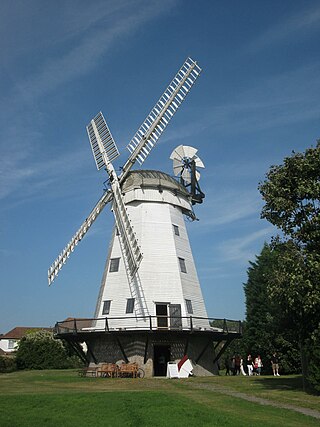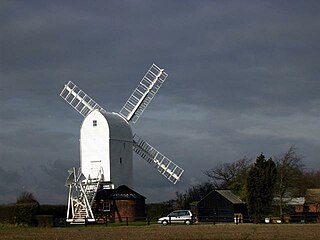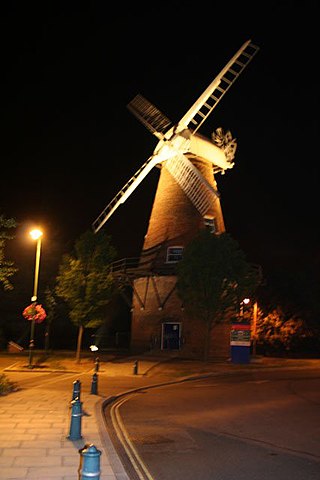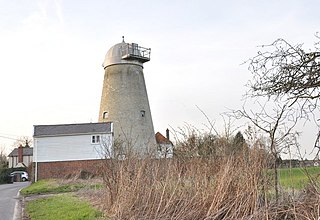
Upminster Windmill is a Grade II* listed smock mill located in Upminster in the London Borough of Havering, England. It was formerly known as Abraham's Mill and was in Essex when built. Between 2016 and 2023 the mill was restored to working order and a visitor centre was constructed. The mill and visitor centre are open to the public at selected times.

John Webb’s or Lowe’s Mill is a Grade II* listed tower mill at Thaxted, Essex, England, which had been restored to working order, but is currently out of action following the loss of a sail in April 2010.

Shirley Windmill is a Grade II listed tower mill in Shirley, in the London Borough of Croydon, England which has been restored to working order.

Aythorpe Roding Windmill is a Grade II* listed Post mill at Aythorpe Roding, Essex, England which has been restored to working order.

Bocking Windmill or Bocking Churchstreet Windmill is a grade I listed post mill at Bocking, Essex, England which has been restored.

Duck End Mill, Letch's Mill or Finchingfield Post Mill is a grade II listed Post mill at Finchingfield, Essex, England which has been restored.

Fryerning Mill is a grade II* listed post mill at Mill Green, Fryerning, Essex, which has been restored.

Mountnessing Windmill is a grade II* listed post mill at Mountnessing, Essex, England. Built in 1807, it was most recently restored to working order in 1983.

Ramsey Windmill is a grade II* listed post mill at Ramsey, Essex, England which has been restored.

Baker Street Mill is a grade II listed smock mill at Baker Street, Orsett, Essex, England which has been part adapted to residential use on its lower two floors only.

Terling Windmill is a grade II listed Smock mill at Terling, Essex, England, which has been converted to residential use.

South Ockendon Windmill was a Smock mill at South Ockendon, Essex, England which collapsed on 2 November 1977.
Debden Windmill is a grade II listed Tower mill at Debden, Essex, England which has been converted to residential use.
Church End Mill is a grade II listed Tower mill at Great Dunmow, Essex, England which has been converted to residential use.

Rayleigh Windmill is a grade II listed Tower mill at Rayleigh, Essex, England which has been restored as a landmark and is used as a museum.

Stansted Mountfitchet Windmill is a grade II* listed Tower mill at Stansted Mountfitchet, Essex, England which is also a Scheduled Ancient Monument. It has been restored and can turn by wind.

Stock Windmill is a grade II* listed tower mill at Stock, Essex, which has been restored.

Messing Maypole Mill is a grade II listed Tower mill at Tiptree, Essex, England which has been converted to a residence. Prior to boundary changes made when the civil parish of Tiptree was established in 1934, the mill was in the parish of Tolleshunt Knights.

Gainsford End Mill is a grade II listed tower mill at Gainsford End, near Toppesfield, Essex, England, which has been converted to a residence.

White Roding Windmill is a Grade II listed preserved tower mill at White Roding, Essex, England.



















